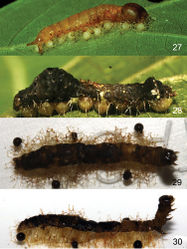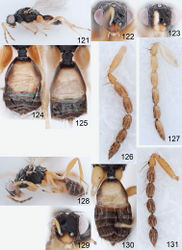Euplectrus billbrowni
| Notice: | This page is derived from the original publication listed below, whose author(s) should always be credited. Further contributors may edit and improve the content of this page and, consequently, need to be credited as well (see page history). Any assessment of factual correctness requires a careful review of the original article as well as of subsequent contributions.
If you are uncertain whether your planned contribution is correct or not, we suggest that you use the associated discussion page instead of editing the page directly. This page should be cited as follows (rationale):
Citation formats to copy and paste
BibTeX: @article{Hansson2015ZooKeys, RIS/ Endnote: TY - JOUR Wikipedia/ Citizendium: <ref name="Hansson2015ZooKeys">{{Citation See also the citation download page at the journal. |
Ordo: Hymenoptera
Familia: Eulophidae
Genus: Euplectrus
Name
Euplectrus billbrowni Hansson sp. n. – Wikispecies link – ZooBank link – Pensoft Profile
Material
Holotype a female labeled “COSTA RICA: Alajuela, ACG, Rio Blanco Abajo, 23.vi.2005, E. Araya, ex Dyops chromatophilaDHJ01 eating Coussapoa nymphaeifolia, sibling of wasp DHJPAR0028838, 05-SRNP-3556” (BMNH). Paratypes: 44♀ 21♂ with same label data as holotype (BMNH, CNC, INBio, MZLU, MIUCR, USNM).
Diagnosis
Lower face medially reddish-brown (female, Fig. 122) or yellowish-white (male, Fig. 123), pale area reaching to outer lateral margin of toruli; scutellum with sides and posterior margin smooth (Fig. 134); female legs yellowish-brown (Fig. 121), male with fore and mid legs predominantly yellowish-white and hind leg yellowish-brown; male antenna with scape slightly expanded, widest in the middle, and 2.8× as long as wide (Fig. 127); petiole 0.8× as long as wide; gaster with anterior ½ yellowish-white with dark brown lateral margins, posterior ½ dark brown (Figs 124, 125).
Description
Female. Length of body 2.2 mm. Antenna with scape and pedicel yellowish-brown, flagellomeres 1–2 dark brown dorsally and yellowish-brown ventrally, 3–6 dark brown (Fig. 126). Mandibles yellowish-brown with base dark brown, palpi white. Head black and shiny, lower face medially reddish-brown, pale area reaching to outer lateral margin of toruli, and with parts lateral to pale area black (Fig. 122). Frons close to eyes with three rows of setae (Fig. 132). Vertex with very weak reticulation (Fig. 133). Occipital margin with a carina behind ocellar triangle (Fig. 133).
Mesosoma black and shiny (Fig. 121). Scutellum 1.0× as long as wide; with rather weak reticulation and with sides and posterior part smooth (Fig. 134). Dorsellum along anterior margin with a groove that is divided by longitudinal carinae (Fig. 739), groove medially 0.3× as long as length of dorsellum. Propodeum with very weak reticulation (Fig. 739); anteromedially with a semicircular cup; propodeal callus with ten setae. Legs yellowish-brown (Fig. 121). Fore wing: costal cell on ventral surface with two rows of setae in basal ½ and one row in apical ½, and margin with one seta close to marginal vein; with 13 admarginal setae in one row.
Gaster with anterior ½ yellowish-white with dark brown lateral margins, posterior ½ dark brown (Fig. 124).
Ratios. HE/MS/WM = 1.9/1.0/1.1; POL/OOL/POO = 8.0/4.1/1.0; OOL/DO = 1.2; WE/WF/WH/HH = 1.0/2.9/5.0/3.7; WH/WT = 1.1; PM/ST = 1.6; TS1/TS2/LT/LT1/LT2/LT3/LT4 = 4.9/3.6/7.1/2.7/1.7/1.0/1.6; LP/WP = 0.8; MM/LG = 1.1.
Male. Length of body 1.8 mm. Scape white, somewhat expanded and widest in the middle (Fig. 127); sensory pores confined to apicoventral ⅔, sensory area white. Similar to female except pedicel and flagellomeres 1–2 yellowish-white and 3–6 brown dorsally and yellowish-brown ventrally (Fig. 127), lower face medially yellowish-white (Fig. 123); fore and mid legs predominantly yellowish-white, gaster shorter.
Ratios. LC/WS = 2.8; MM/LG = 1.3.
Hosts and biology
Feeding on last instar larva of Dyops chromatophilaDHJ01 (Erebidae) feeding on Coussapoa nymphaeifolia (Urticaceae), parasitoid cocoons stuck to dead larva and substrate.
Distribution
Costa Rica (Alajuela Province).
Etymology
This species is named after Bill L. Brown, in recognition of his contribution to the understanding of ACG Hymenoptera taxonomy.
Original Description
- Hansson, C; Smith, M; Janzen, D; Hallwachs, W; 2015: Integrative taxonomy of New World Euplectrus Westwood (Hymenoptera, Eulophidae), with focus on 55 new species from Area de Conservación Guanacaste, northwestern Costa Rica ZooKeys, (485): 1-236. doi
Images
|



